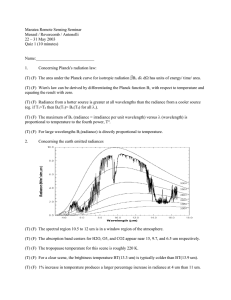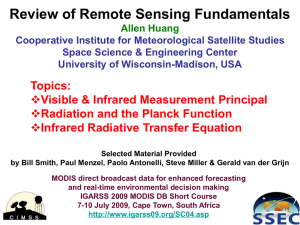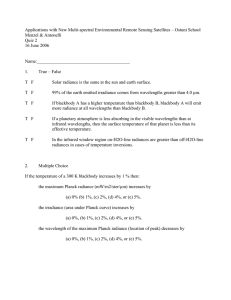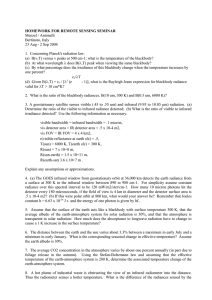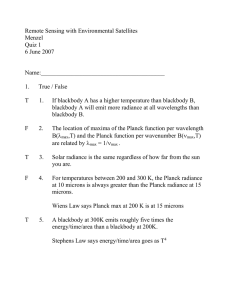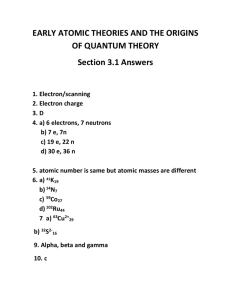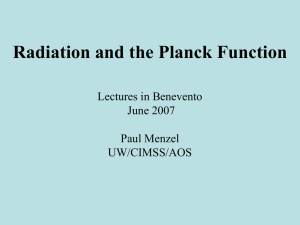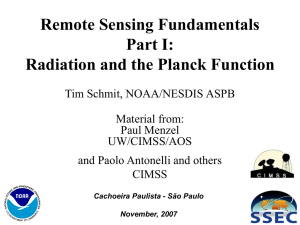Review of Remote Sensing Fundamentals
advertisement
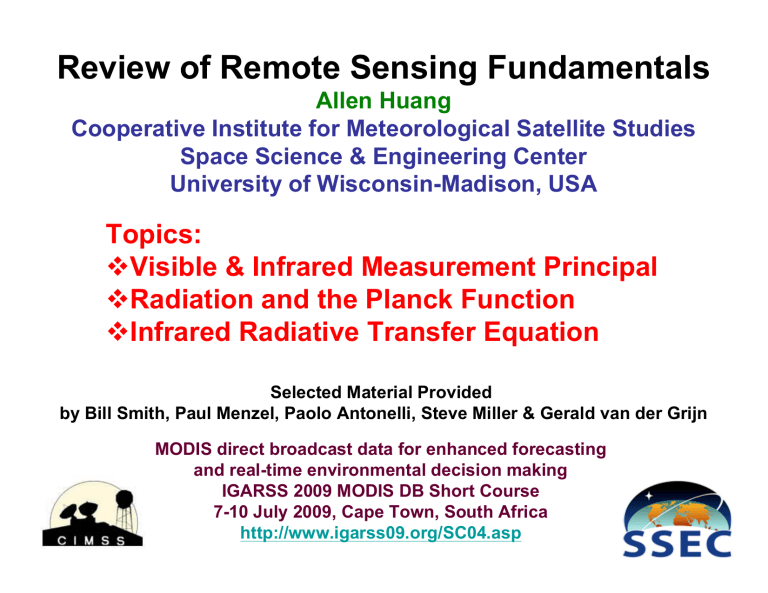
Review of Remote Sensing Fundamentals
Allen Huang
Cooperative Institute for Meteorological Satellite Studies
Space Science & Engineering Center
University of Wisconsin-Madison, USA
Topics:
Visible & Infrared Measurement Principal
Radiation and the Planck Function
Infrared Radiative Transfer Equation
Selected Material Provided
by Bill Smith, Paul Menzel, Paolo Antonelli, Steve Miller & Gerald van der Grijn
MODIS direct broadcast data for enhanced forecasting
and real-time environmental decision making
IGARSS 2009 MODIS DB Short Course
7-10 July 2009, Cape Town, South Africa
http://www.igarss09.org/SC04.asp
1
Earth System Energy Balance
2
Radiative Energy Balance
3
Remote Sensing of Natural Radiation
Visible & Near IR
Infrared (IR)
(Reflective Bands)
(Emissive Bands)
4
What do satellites actually measure ?
They measure TEMPERATURE, HUMIDITY,
WIND, TRACE GASES, CLOUDS,
AEROSOLS, OTHERS…, indirectly!
Instead, satellite observations are
obtained using remote sensing
techniques based on measurements of
electromagnetic radiation
5
Electromagnetic Radiation
Every object with a temperature larger than 0 K emits electromagnetic radiation. Electromagnetic
radiation therefore extends over a wide range of energies and wavelengths. The distribution of all
radiant energies can be plotted in a chart known as the electromagnetic spectrum.
6
The Electromagnetic (EM) Spectrum
Remote sensing uses radiant energy that is reflected and
emitted from Earth at various “wavelengths” of the
electromagnetic spectrum
Our eyes are sensitive to the visible portion of the EM
spectrum
7
Electromagnetic Radiation
In the earth’s atmosphere, the radiation is partly to completely transmitted at
some wavelengths; at others those photons are variably absorbed by interaction
with air molecules.
Blue zones mark minimal passage of incoming and/or outgoing radiation, whereas, white areas
denote atmospheric windows in which the radiation doesn’t interact much with air molecules.
Most remote sensing instruments operate in one of these windows by making
their measurements tuned to specific frequencies that pass through the
atmosphere. Some sensors, especially those on meteorological satellites,
directly measure absorption phenomena.
9
UV, Visible and Near-IR and IR and Far-IR
Far-Infrared (IR)
Infrared (IR)
UV, Visible and Near-IR
10
MODIS Visible and Near-infrared Bands
O2
O3
H2O
O2
H2O
H2O
H2O
O2
H2O
H2O
Visible
CO2
Near IR
11
MODIS Reflected Solar Bands
12
Units: Wavelength (µm) vs. Wavenumber) (cm-1)
wavelength λ (µm) : distance between peaks
wavenumber ν (cm-1): number of waves per unit distance
λ=1/ ν
dλ=-1/ ν2 d ν
λ (µm) = 10,000 / ν (cm-1)
Radiation is characterized by wavelength λ and amplitude a13
Terminology of radiant energy
Energy from
the Earth Atmosphere
over time is
Flux
which strikes the detector area
Irradiance
at a given wavelength interval
Monochromatic
Irradiance
over a solid angle on the Earth
Radiance observed by
satellite radiometer
is described by
The Planck function
can be inverted to
Brightness temperature
14
Terminology of radiant energy
Energy (Joules) from
the Earth Atmosphere
over time is
Flux (Joules/sec or W)
which strikes the detector area
Irradiance (W/m2)
at a given wavelength interval
Monochromatic
Irradiance (W/m2/micrometer)
over a solid angle on the Earth
Radiance (W/m2/micromenter/ster) observed by
satellite radiometer
is described by
The Planck function
can be inverted to
Brightness temperature (K)
15
Definitions of Radiation
__________________________________________________________________
QUANTITY
SYMBOL
UNITS
__________________________________________________________________
Energy
dQ
Joules
Flux
dQ/dt
Joules/sec = Watts
Irradiance
dQ/dt/dA
Watts/meter2
Monochromatic
Irradiance
dQ/dt/dA/dλ
W/m2/micron
or
Radiance
dQ/dt/dA/dν
W/m2/cm-1
dQ/dt/dA/dλ/dΩ
W/m2/micron/ster
or
dQ/dt/dA/dν/dΩ
W/m2/cm-1/ster
__________________________________________________________________
17
Radiation is governed by Planck’s Law
In wavelength:
B(λ,T) = c1 /{ λ 5 [e c2 /λT -1] } (mW/m2/ster/cm)
where
λ = wavelength (cm)
T = temperature of emitting surface (deg K)
c1 = 1.191044 x 10-8 (W/m2/ster/cm-4)
c2 = 1.438769 (cm deg K)
In wavenumber:
B(ν,T) = c1ν3 / [e c2ν/T -1]
where
(mW/m2/ster/cm-1)
ν = # wavelengths in one centimeter (cm-1)
T = temperature of emitting surface (deg K)
c1 = 1.191044 x 10-5 (mW/m2/ster/cm-4)
c2 = 1.438769 (cm deg K)
Brightness temperature is uniquely related to radiance for a given
wavelength by the Planck function.
21
Using wavelengths
c2/λT
B(λ,T) = c1 / λ5 / [e
-1]
Planck’s Law
where
(mW/m2/ster/cm)
λ = wavelengths in cm
T = temperature of emitting surface (deg K)
c1 = 1.191044 x 10-5 (mW/m2/ster/cm-4)
c2 = 1.438769 (cm deg K)
dB(λmax,T) / dλ = 0 where λ(max) = .2897/T
Wien's Law
indicates peak of Planck function curve shifts to shorter wavelengths (greater wavenumbers)
with temperature increase. Note B(λmax,T) ~ T5.
∞
Stefan-Boltzmann Law E = π ∫ B(λ,T) dλ = σT4, where σ = 5.67 x 10-8 W/m2/deg4.
o
states that irradiance of a black body (area under Planck curve) is proportional to T4 .
Brightness Temperature
c1
T = c2 / [λ ln( _____ + 1)] is determined by inverting Planck function
22
λ5Bλ
Spectral Distribution of Energy Radiated
from Blackbodies at Various Temperatures
23
24
Using wavenumbers
dB(νmax,T) / dT = 0 where ν(max) = 1.95T
Wien's Law
indicates peak of Planck function curve shifts to shorter wavelengths (greater wavenumbers)
with temperature increase. Note B(νmax,T) ~ T**3.
∞
Stefan-Boltzmann Law E = π ∫ B(ν,T) dν = σT4, where σ = 5.67 x 10-8 W/m2/deg4.
o
states that irradiance of a black body (area under Planck curve) is proportional to T4 .
Brightness Temperature
c1ν3
T = c2ν/[ln(______ + 1)] is determined by inverting Planck function
Bν
Brightness temperature is uniquely related to radiance for a given
wavelength by the Planck function.
25
26
B(λmax,T)~T5
B(νmax,T)~T3
λmax ≠(1/ νmax)
Planck Radiances
180
160
B(λ,T) versus B(ν,T)
B(λ,T)
140
mW/m2/ster/cm (cm-1)
120
100
80
B(ν,T)
60
40
20
0
0
5
10
20
10
15
20
25
30
5
4
3.3
wavenumber (in hundreds)
100
6.6
wavelength [µm]
27
Using wavenumbers
Using wavelengths
c2ν/T
B(ν,T) = c1ν3 / [e
-1]
(mW/m2/ster/cm-1)
c2 /λT
B(λ,T) = c1 /{ λ 5 [e
-1] }
(mW/m2/ster/μm)
ν(max in cm-1) = 1.95T
λ(max in cm) = 0.2897/T
B(νmax,T) ~ T**3.
B(λ max,T) ~ T**5.
∞
E = π ∫ B(ν,T) dν = σT4,
o
c1ν3
T = c2ν/[ln(______ + 1)]
Bν
∞
E = π ∫ B(λ,T) d λ = σT4,
o
c1
T = c2/[λ ln(______ + 1)]
λ5 Bλ
Wavelength (µm) vs. Wavenumber (cm-1) 28
Energy conservation: τ + a + r = 1
τ+a+r=1
=ελBλ(Ts)
Reflected
T
Absorbed
Transmitted
Rλ=(aλ +rλ +τλ) Rλ
τ+a+r=1
29
Temperature sensitivity
dB/B = α dT/T
The Temperature Sensitivity α is the percentage
change in radiance corresponding to a percentage
change in temperature
Substituting the Planck Expression, the equation can
be solved in α:
α=c2ν/T
30
∆B11> ∆B4
∆B11
∆B4
T=300 K
Tref=220 K
31
B=Bref(T/Tref)α
⇓
B=(Bref/ Trefα) T α
⇓
B∝ T α
The temperature sensitivity indicates the power to which the Planck radiance
depends on temperature, since B proportional to Tα satisfies the equation. For
infrared wavelengths,
α = c2ν/T = c2/λT.
__________________________________________________________________
Wavenumber
900
2500
Typical Scene
Temperature
300
300
Temperature
Sensitivity
4.32
11.99
34
Temperature Sensitivity of B(λ,T) for typical earth scene temperatures
B (λ, T) / B (λ, 273K)
4μm
6.7μm
2
10μm
15μm
microwave
1
200
250
Temperature (K)
300
36
B(10 um,T) / B(10 um,273) ∝ T4
B(10 um,273)= 6.1
B(10 um,200)= 0.9 → 0.15
B(10 um,220)= 1.7 → 0.28
B(10 um,240)= 3.0 → 0.49
B(10 um,260)= 4.7 → 0.77
B(10 um,280)= 7.0 → 1.15
B(10 um,300)= 9.9 → 1.62
1
200
300
38
B(4 um,T) / B(4 um,273) ∝ T12
B(4 um,273)= 2.2 x 10-1
B(4 um,200)= 1.8 x 10-3 → 0.0
B(4 um,220)= 9.2 x 10-3 → 0.0
B(4 um,240)= 3.6 x 10-2 → 0.2
B(4 um,260)= 1.1 x 10-1 → 0.5
B(4 um,280)= 3.0 x 10-1 → 1.4
B(4 um,300)= 7.2 x 10-1 → 3.3
1
200
300
39
B(0.3 cm, T) / B(0.3 cm,273) ∝ T
B(0.3 cm,273)= 2.55 x 10-4
B(0.3 cm,200)= 1.8 → 0.7
B(0.3 cm,220)= 2.0 → 0.78
B(0.3 cm,240)= 2.2 → 0.86
B(0.3 cm,260)= 2.4 → 0.94
B(0.3 cm,280)= 2.6 → 1.02
B(0.3 cm,300)= 2.8 → 1.1
1
200
300
40
Reflection and Transmission of Plane-Parallel
Layers
F0
τ=0
reflection
transmission
R(τt; µ, φ; µ0, φ0)
T(τt; µ, φ; µ0, φ0)
τ = τt
R(τa, ω0; µ, µ0, φ) =
where
µ
=
µ0 =
φ
=
πI(0, –µ, φ)
µ0F0
absolute value of the cosine of the zenith angle |cosθ|
cosine of the solar zenith angle cosθ0
relative azimuth angle between the direction of propagation of the emerging
radiation and the incident solar direction
41
Visible: Reflective Bands
Used to observe solar energy reflected by the Earth
system in the:
• Visible between 0.4 and 0.7 µm
• NIR between 0.7 and 3 µm
About 99% of the energy observed between 0 and 4 µm
is solar reflected energy
Only 1% is observed above 4 µm
43
Sensor Geometry
Electronics
Sensor
Optics
44
Reflectance
• To properly compare different reflective channels we
need to convert observed radiance into a target
physical property
• In the visible and near infrared this is done through
the ratio of the observed radiance divided by the
incoming energy at the top of the atmosphere
• The physical quantity is the Reflectance i.e. the
fraction of solar energy reflected by the observed
target
45
Soil
Vegetation
Snow
Ocean
46
More than 75% of the
Observed energy
Over Ocean
In the blue bands
Is due to atmospheric
Scattering.
Less than 25% is due
to Water
Leaving Energy
After Atmospheric Correction
Values Range between [0 25] W/ster/cm2/ µm
Radiance observed
In the Blue Band
At 0.41 µm
Before Atmospheric Correction
Values Range [50 100] W/ster/cm2/ µm
49
Band 4
(0.56 Micron)
w
o
n
s
d
u
o
cl
Band 1
Band 4
Band 3
s
des
ert
se
a
Transects of Reflectance
50
Band 20
1.38 micron
Strong H20
52
Only High Clouds
Are Visible
53
Ocean: Dark
Vegetated
Surface: Dark
NonVegetated
Surface: Brighter
Clouds: Bright
Snow: Bright
Sunglint
54
Ocean: Dark
Vegetated
Surface: Dark
NonVegetated
Surface: Brighter
Clouds: Bright
Snow: Bright
Sunglint
55
Ocean: Dark
Vegetated
Surface: Dark
NonVegetated
Surface: Brighter
Clouds: Bright
Snow: Bright
Sunglint
56
MODIS Thermal Emissive Bands
Primary Atmospheric Band
Bandwidth1
(K)
Application
Surface Temperature
Ttypical
Radiance2
NEΔT (K)
at Ttypical Specification
NEΔT (K)
Predicted
20
3.660-3.840
300
0.45
0.05
0.05
22
3.929-3.989
300
0.67
0.07
0.05
23
4.020-4.080
300
0.79
0.07
0.05
24
4.433-4.498
250
0.17
0.25
0.15
25
4.482-4.549
275
0.59
0.25
0.10
27
6.535-6.895
240
1.16
0.25
0.05
28
7.175-7.475
250
2.18
0.25
0.05
29
8.400-8.700
300
9.58
0.05
0.05
Ozone
30
9.580-9.880
250
3.69
0.25
0.05
Surface Temperature
31
10.780-11.280
300
9.55
0.05
0.05
32
11.770-12.270
300
8.94
0.05
0.05
33
13.185-13.485
260
4.52
0.25
0.15
34
13.485-13.785
250
3.76
0.25
0.20
35
13.785-14.085
240
3.11
0.25
0.25
36
14.085-14.385
220
2.08
0.35
0.35
Temperature profile
Moisture profile
Temperature profile
57
MODIS Infrared Spectral Bands
Short Wave IR
Long Wave IR
58
AIRS
(Atmospheric Infrared Sounder)
& MODIS – IR only
59
AIRS
(Atmospheric Infrared Sounder)
& MODIS
60
Emissive Bands
Used to observe terrestrial energy emitted by the Earth
system in the IR between 4 and 15 µm
• About 99% of the energy observed in this range is
emitted by the Earth
• Only 1% is observed below 4 µm
• At 4 µm the solar reflected energy can significantly
affect the observations of the Earth emitted energy
61
Spectral Characteristics of Energy Sources and Sensing Systems
IR
4 µm
11 µm
62
Observed Radiance
at 4 micron
Window Channel:
•little atmospheric absorption
•surface features clearly visible
Range [0.2 1.7]
Values over land
Larger than over water
Reflected Solar everywhere
Stronger over Sunglint
63
Observed Radiance
at 11 micron
Window Channel:
•little atmospheric absorption
•surface features clearly visible
Range [2 13]
Values over land
Larger than over water
Undetectable Reflected Solar
Even over Sunglint
64
Brightness Temperature
• To properly compare different emissive
channels we need to convert observed
radiance into a target physical property
• In the Infrared this is done through the Planck
function
• The physical quantity is the Brightness
Temperature i.e. the Temperature of a black
body emitting the observed radiance
65
Observed BT
at 4 micron
Window Channel:
•little atmospheric absorption
•surface features clearly visible
Range [250 335]
Clouds are cold
Values over land
Larger than over water
Reflected Solar everywhere
Stronger over Sunglint
66
Observed BT
at 11 micron
Window Channel:
•little atmospheric absorption
•surface features clearly visible
Range [220 320]
Clouds are cold
Values over land
Larger than over water
Undetectable Reflected Solar
Even over Sunglint
67
AIRS
(Atmospheric Infrared Sounder)
& MODIS – IR only
68
Real atmospheric weighting functions
High in the atmosphere very little
radiation is emitted, but most will
reach the top of the atmosphere.
z
At some level there is an optimal balance between the
amount of radiation emitted and the amount reaching
the top of the atmosphere.
A lot of radiation is emitted from the dense lower
atmosphere, but very little survives to the top of the
atmosphere due to absorption.
K(z)
K(z)
69
Weighting Functions
Longwave CO2
14.7
1
14.4
2
14.1
3
13.9
4
13.4
5
12.7
6
12.0
7
680
696
711
733
748
790
832
Midwave H2O & O3
11.0
8
907
9.7
9
1030
7.4
10
1345
7.0
11
1425
6.5
12
1535
CO2, strat temp
CO2, strat temp
CO2, upper trop temp
CO2, mid trop temp
CO2, lower trop temp
H2O, lower trop moisture
H2O, dirty window
window
O3, strat ozone
H2O, lower mid trop moisture
H2O, mid trop moisture
H2O, upper trop moisture
72
Radiance measured by IR Sensor
RTE (no scattering) in LTE
Rν = τ sν ⋅ ε sν ⋅ Bν (TS )
0
+ ∫ Bν (T ( p ))dτν ( p )
ps
0
← Upwelling IR radiation from surface
← Upwelling IR radiation from atm. layers
− τ sν ⋅ rsν ⋅ ∫ Bν (T ( p ))dτν∗ ( p )
← Reflected downwelling IR radiation
sun
+ Rνsun ⋅ cos(θ ) ⋅τ ssun
(
p
)
⋅
r
ν
ν
s
← Reflected solar radiation
ps
R…radiance, υ…wavenumber, s…surface, p…pressure, sun…solar,
T…temperature, B…Planck function, ε …emissivity,
τ…level to space transmittance, θ...local solar zenith angle
r…reflectivity, with r = (1- ε)/π,
τ*…level to surface (downwelling) transmittance [τ*= τυ2(ps)/ τυ(p)]
73
Solar Effects (Day Vs. Night) on
Infrared Measurements
74
Radiative Transfer Equation
Summary
Radiative Transfer Equation in Infrared:
models the propagation of terrestrial emitted energy
through the atmosphere by
• absorption,
• scattering,
• emission and
• reflection
of gases, clouds, suspended particles, and surface.
The modeled radiances can be converted to brightness
temperature and inverted to obtain atmospheric
variables such as profile of temperature and water
vapor profiles and clouds (height, fraction, optical
thickness, size), aerosol/dust, surface temperature,
and surface types etc…..
75
Summary
• Radiance is the Energy Flux (emitted and/or reflected
by the Earth) which strikes the Detector Area at a
given Spectral Wavelength (wavenumber) over a
Solid Angle on the Earth;
• Reflectance is the fraction of solar energy reflected to
space by the target;
• Given an observed radiance, the Brightness
Temperature is the temperature, in Kelvin, of a
blackbody that emits the observed radiance;
• Knowing the spectral reflective (Vis) and emissive
(IR) properties (spectral signatures) of different
targets it is possible to detect: clouds, cloud
properties, vegetation, fires, ice and snow, ocean
color, land and ocean surface temperature …… 76
